Archive for December, 2005
December 20, 2005 at 9:32 am · Filed under FAQs
I just tallied up some of our expenses for the trip. Our total campground expense to date has been $848.50, which includes all of our overnight stays from October 1 through December 20.
That’s remarkably low, because we have taken every opportunity to boondock and courtesy park. For example, our 13 days at Cherry Creek State Park in Aurora CO cost us $318.00 ($20 per day plus a park pass). But 14 days of courtesy parking in California and Oregon (Nov 5-18) cost us nothing. The savings of courtesy parking are huge, and we appreciate it when people offer us a space. Plus, it’s more fun!
Our camping expenses have risen lately. California state parks are generally more expensive and we’ve had fewer courtesy parking opportunities in the crowded areas along the coast. Paradoxically, the closer we are to cities, the fewer people can offer us a space. Neighborhood covenants, zoning restrictions, and limited parking space are the culprits.
Fuel has been another story. Since we spent most of October and early November logging about 6,000 miles, we purchased about $1,200 worth of gasoline. The way to reduce this cost is to drive less, but in our case we needed to get west before the cold weather set in, and so we had a large upfront expense to get out here. Now that we are here, we are spending much less on gas.
We also bought several 30# tanks of propane due to the cold nights in Denver and other high altitude areas, totalling about $150. Our usage is going down now, as we get into warmer evenings in southern California.
Although everyone focuses on the cost of campsites, the real expense turns out to be meals out and splurges. We can easily spend more on eating out in one day than we can on the campground, and a set of tickets for the family to go to an attraction (Monterey Bay Aquarium, Hearst Castle, etc) typically runs $30-50. We keep that under control by aiming for free natural attractions, like hiking, cycling, visiting friends, and beachcombing. Our ASTC Travel Passport is a big help. It gets us into science and discovery museums all over the country for free. Our National Parks pass is also great.
No matter which way we look at it, it is cheaper to travel in our Airstream than live at home. Of course, if we still had a house back in Vermont it would be a different story — a life on the road would be an added expense. I recognize that is the reality for most people, but hopefully our experience gives you an idea of ways you can keep the expenses down and have fun while doing it.
December 19, 2005 at 5:38 pm · Filed under Places to go
Well, our luck has changed. Not only has the weather improved (upper 60s and partly cloudy), but we stopped in at a state beach and found a really nice spot to camp just south of Santa Barbara.
To be honest, it wasn’t all luck. We picked up a copy of the California state park brochure called the “Guide to Reserving State Park Campsites” several weeks ago, and it has become our cheat sheet ever since. We knew that Carpinteria would offer us hookups. After three nights of dry camping we felt like not having to worry about using the lights and water as much.
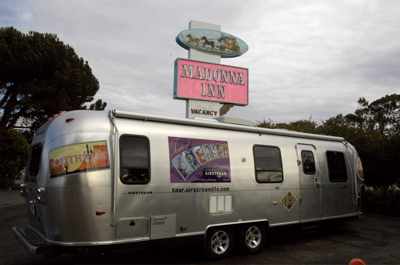
On the way, we stopped at the famous Madonna Inn. The last time I was here was in 1979. I am pleased to report that the Men’s room has not changed significantly. The waterfall urinal is still there. Those of you who have visited the Men’s room at the Madonna Inn will know what I mean.
We also made a shopping stop, for Christmas stuff. Although we had Christmas in Vermont, we have advised Emma that Santa will visit us no matter where we are. Eleanor wants to get the trailer ready, so we bought a little potted rosemary plant, which looks remarkably like a small fir tree. This will get decorated with tiny ornaments, and after Christmas it will probably be eaten! Eleanor is hanging cards and stockings in the trailer as I type this, and Emma is making paper decorations. Everything is lightweight, small, and either recyclable or edible — perfect for mobile life.
Our campsite at Carpinteria is right next to the beach, with full hookups. We are literally forty feet from the sand, and can hear the waves crashing and the beach stones tumbling with every wave. The evening is balmy, many of our neighbors have festive lights up, and there’s even an Airstream Classic motorhome (a 290) parked just a few spaces away. (I’ll go see them in the morning.)
We arrived so close to sunset that I pushed Eleanor and Emma out of the truck as soon as we pulled in, and said, “Go to the beach! Now!”, which they did happily. They caught about 20 minutes of fun collecting shells and splashing in the surf before it got too dark to see. I ran over to join them as soon as I had the truck unhitched, but of course that meant I had to set up the utilities in the dark. Not a big price to pay.
We’ll definitely stay a couple of nights here at least. Our thought is to try another state beach campsite in Huntington Beach and stay there through Christmas. If anyone has experience with that campground, let us know how it is.
December 19, 2005 at 6:48 am · Filed under FAQs
In response to your requests, I have created a map which shows all the places we’ve stopped so far on our Tour. You can see it by clicking the link below.
I used a new service called “Frappr” to make it. You might note that Frappr allows you to add yourself to the map. But please don’t do that in this case, otherwise it will be hard to tell which of the pinpoints are Tour stops and which are blog readers like yourself.
Each “pin” on the map is a place we’ve spent at least one night. I’ll keep updating this map as we travel.
Click here to see where we’ve been!
December 18, 2005 at 5:35 pm · Filed under Uncategorized
This has to be the worst weather we have encountered since we left Jackson Center, OH in early October. Gusty strong winds, frequent rain, 50s — a real blustery damp day, not the sort of weather one associates with coastal southern California.
But they do get weather here, and there wasn’t much to do about it but go ahead and investigate Hearst Castle as planned. The conditions made a challenging photographic subject even more difficult. They don’t allow any sort of flash photography inside the buildings, and all the rooms are dimly lit to preserve the art inside. I had to crank the camera’s ISO up to 1600 to get anything at all, and most of the photos were hopeless. I even got a reprimand from the tour guide for the Nikon’s “AF assist” light, which briefly illuminates the subject to help the autofocus system, so that feature got shut off, too.
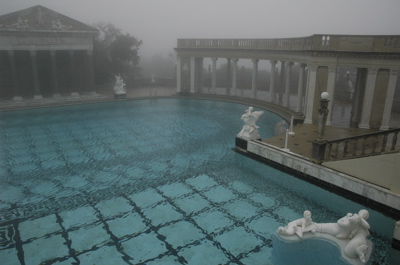
Outside, the same prohibition on flashes seems to apply (although you would think the marble statues wouldn’t care if they can take the direct sunlight), and the whipping wind, rain, and fog pretty much wiped out all photo opportunities. The photo above is of the heated outdoor “Neptune pool” which was rebuilt twice as Hearst enlarged it. Believe it or not, this is the best shot I got all day.
Emma survived the 1 hr, 45 minute house tour fairly well, but with that length (and at $20 per adult) we decided one was enough for our family. We had an expensive set of hamburgers made from former 4-legged residents of the Hearst ranch ($25 with drinks and fries), saw the movie, toured the exhibits, and fled. I suspect it’s a nicer trip on a sunny day, but today the lack of central heating in much of the Visitor’s Center and the house itself was painfully apparent. It felt like visiting the dungeons of some European castle.
The sea is stormy, exciting, and worth watching today, but now that dark has fallen we are thinking about where we will head next. Forecasts claim we will have better weather tomorrow.
December 18, 2005 at 7:45 am · Filed under FAQs
I’m glad we did take a night at a downtown hotel in San Francisco, but I doubt we’ll do it too much on this trip. The rate looked OK when we booked it: $109 per night. By comparison, the Hyatt Regency Embarcadero down the street was $265. So I thought, “Hey, that’s a good deal for downtown!”
But let’s see how that added up:
base rate $109.00
parking $36.0 (yikes!)
tax on parking $5.04 (they tax parking here?)
tax on hotel $15.26
TOTAL $165.30
Plus the optional extras, which I avoided:
— T-Mobile Hotspot Internet access for one day $9.99 (I picked up a signal from the Holiday Inn across the street, which gives guests free access for a day)
— Calistoga spring water in room $4.50 (Eleanor, put down that bottle!)
— And heaven help you if you make a long-distance call on the room phone.
At that rate, our 9 weeks of travel so far (not counting our week in Vermont) would have cost $10,413.90. Even at the national average or $85 per night, it would have been $5,355. We haven’t spent anywhere near that on lodging, with the Airstream, even counting the gas to haul it around.
People ask us about budgeting, but nobody wants to come right out and ask us what this trip is costing. To tell the truth, I don’t really know yet. I haven’t tallied it up, but I do know that it is less than it cost us to stay home. Our increased expenses (campsites, extra fuel, cell phones, etc) are more than compensated by the decreased expenses (no mortgage, real estate taxes, winter heating bill, utilities, ec). But we’ll have to watch it on the hotel splurges, that’s for certain!
December 17, 2005 at 6:23 pm · Filed under Places to go
We’ve been driving coastal Route 1 south from Santa Cruz and it just keeps getting better. I have tons of pictures but for now I’ll just post a few and try to get a new photo album up in the next few days.
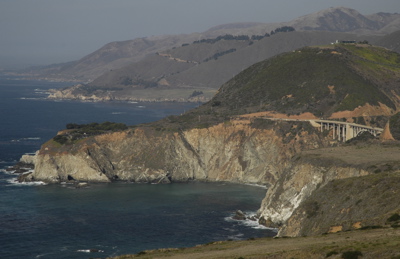
Our progress has been deliberately slow. Route 1 is a road to be savored. There are pullouts every mile or so, and nearly every one offers spectacular views to the Pacific Ocean on one side, and the hills rising on the other.
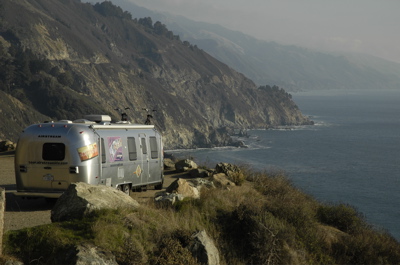
Somewhere south of Big Sur we pulled over and spotted a flock of six condors hovering in the breeze. These enormous birds were nearly extinct at one time, but they are recovering. What an impressive sight to see a condor, with a wingspan bigger than you are, swooping right over your head!
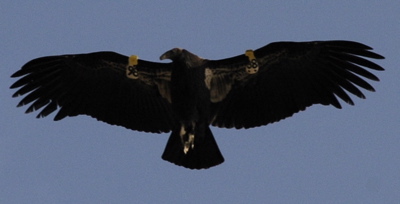
Last night we camped at the Kirk Creek National Forest Service campground, which is part of the Los Padres National Forest. (No hookups, questionable water, $20 per night.) This spectacular campground sits atop a bluff overlooking the ocean, and there are wonderful trails down to the sea. From our campsite we could hear the thudding of huge waves breaking on the rocks. I wish it had been warm enough to sleep with the windows open.
Hunting for interesting rocks near our campsite, Eleanor and Emma discovered opal. Yes, opal. We are not sure yet if it occurs naturally in this area or if someone simply left bits of a larger one there, but we found about 1/4 lb of it in small fragments, ranging in color from nearly white to black-blue. We have saved the bits and plan to mail a few to Emma’s grandparents for polishing.
This morning, the day became overcast (but still 60 degrees), and the wind picked up. We made fewer stops along the coast but when we spotted elephant seals on the beach, we had to take a look.
It turns out that there’s a stretch of coastline just north of San Simeon where another endangered creature, the elephant seal, has been visiting annually for the past 12 years. They come to mate and give birth, all the way from their summer home in the Aleutian Islands. “Friends of the Elephant Seal”, a local group, act as docents and were standing nearby in blue jackets to help educate us about these fascinating animals.
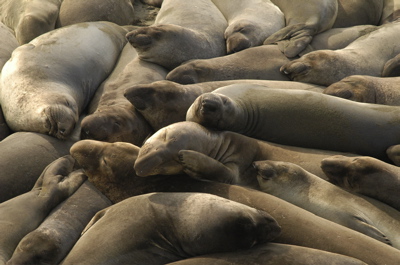
The seals get up to 5,000 lbs. The beach was mostly filled with young males, who arrive a few weeks before the big guys arrive. When the big males show up, they battle for bits of the beach (mostly by bellowing) and then gather a harem of 30-40 already-pregnant females. The females give live birth on the beach, nurse the pup for 28 days, and then they are free to mate with the male. If the pup has gained enough weight (200 lbs!) it will teach itself how to swim and fish. Otherwise, tough luck.
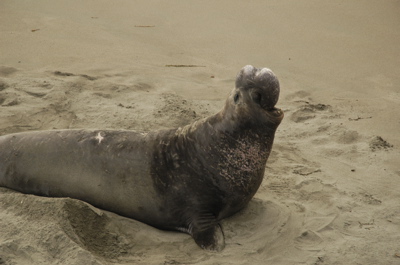
An elephant seal can swim to 5,000 feet below the sea! It has super-oxygenated blood (and a lot of it) and some other tricks to allow it to avoid breathing for hours. We learned all this and more in a 30 minute visit, while the elephant seals snoozed and bellowed on the sand just a few feet away.
The rest of the day was spent running errands in the cute little town of Cambria, CA, just a couple of miles south of Hearst Castle. We needed everything: post office, ATM, propane, gas, water, dump station, and groceries. By the time we finished all that, the sun was setting and it was time to get back to our campsite at San Simeon State Park. We’ll spend tomorrow at Hearst Castle and then head further south on Monday.
December 16, 2005 at 7:58 am · Filed under Uncategorized
What a great town for street hiking, eating, and photography — three of my favorite things. I couldn’t wait to get everyone out of the hotel and on the street. I was up early, the rest of the gang was not …

When we finally did get out, Emma was interested in the “F” line historic streetcars, so we hopped on one of the 1940s green-and-white PCC cars (originally from Philadelphia) and rode down The Embarcadero.

The F line swings around the waterfront on The Embarcadero and then down Market Street into the heart of the SF business district. We got off at Powell Street, where the cable cars terminate, and walked north (uphill) a dozen blocks, taking in the sights.

A stop at the Westin St Francis hotel’s elaborate gingerbread house was a hit with Emma, but it made us all hungry for breakfast.

So, a few blocks later, on the downside of the hill we stopped at a small Chinese restaurant and bought 3 large pieces of dim sum for breakfast. Emma liked the deep-fried bun with ham in it (not sure of the proper name), Eleanor liked the sesame lotus bun with sweet bean paste (sort of like a filled doughnut), and I liked the translucent potsticker with cabbage and pork. We munched and walked down to our hotel, 24 blocks in all.
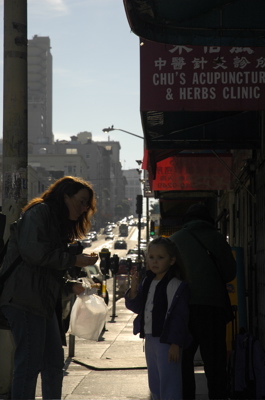
After checking out of the hotel, we headed the to streetcars again, this time to catch one of the orange “Peter Witt” cars from Milan Italy. These feature gorgeous wood interiors and signs in Italian. (“Vietato sputare” was one.) Emma was hoping they’d be more rickety than the PCC cars, but the ride was just as smooth.
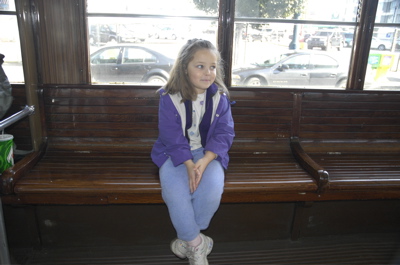
We got off the streetcar a bit earlier this time, so that we could hike the famed stairs to Coit Tower, on the bay side. Toward the top of the stairs there is a spot where two hundred wild parakeets live in the trees. I got some good shots of them eating berries, and a local commented that I had been lucky enough to get closer to the birds than anyone he had ever seen.
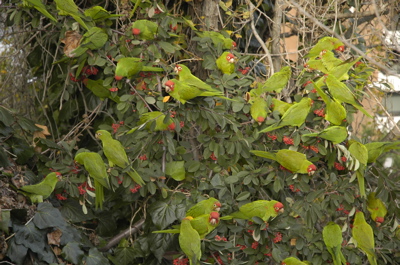
The views from Coit Tower were, as always, spectacular. I can’t imagine a bad view, unless the visibility was zero in fog. (This time of year there’s less fog than in the summer.) And the entire Telegraph Hill residential area that surrounds the tower is interesting to browse.

After hiking down the west side from Coit Tower, we turned south and headed for Chinatown. I wanted to revisit a place I’d had lunch with my friend Captain Mikey a few years ago: Yee’s. It’s one of those places where the cooked chickens hang in the window, the clientele is almost entirely Chinese, and a row of old men stand behind the counter with cleavers, whacking pieces of poultry for the 3 o’clock buffet. Perfect.
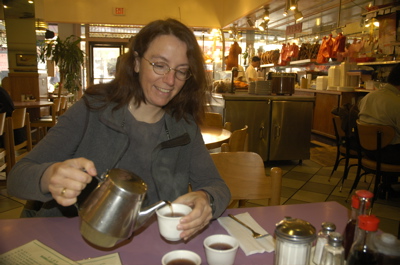
The lunches were marvelous and enormous (enough for leftovers), the atmosphere was friendly, and lunch was just $15 for all three of us. We saved a little room in our stomachs so we could walk one block up hill to an Italian gelato shop. Lemon for me, green tea flavor for Eleanor, and a lemon cone for Emma.
Browsing San Francisco by foot is the best way to see the bulk of town. The hills offer remarkable views that continually surprise. Later, you can drive or bicycle over the Golden Gate bridge, Golden Gate Park, and other great spots. But from the hills, you can see it all and really get a sense of what San Francisco is all about.
We wrapped up our afternoon with a walk over to the Fisherman’s Wharf piers. This part of town is very touristy, but the sea lions and waterfront scenery are still worth a look. Plus, Pier 39 offers some of the best views of San Francisco in the late afternoon.
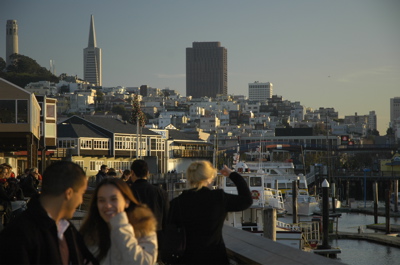
Once the sun set, it was time to start heading back home to the Airstream. We stopped in Cupertino to visit some friends for a couple of hours, and then returned to our storage spot in Santa Cruz to find our Airstream glowing in the light of the full moon on a crisp California night.
« Previous entries ·
Next entries »


















